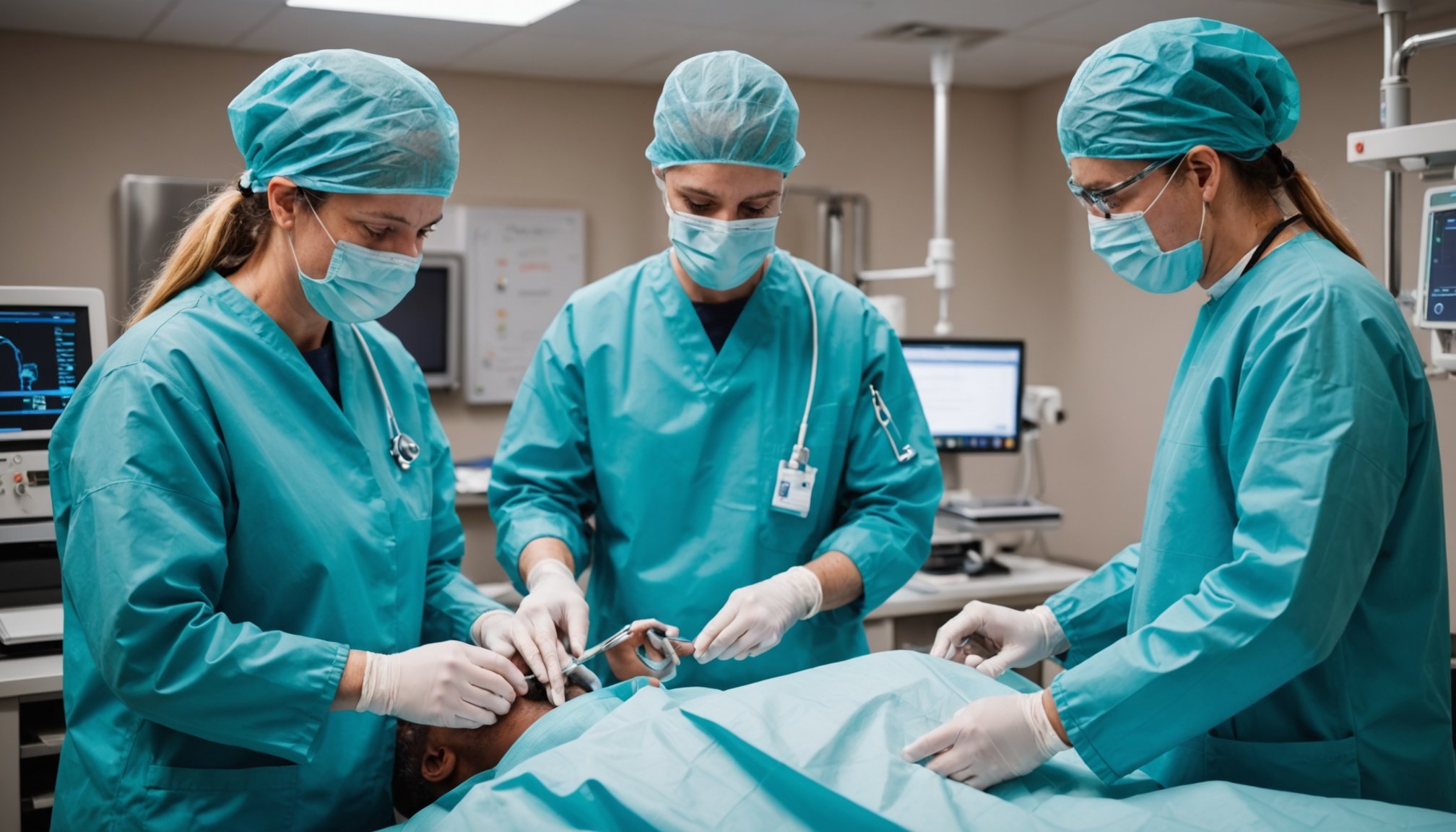Introduction to Perioperative Care Optimization
In the medical field, perioperative care is a crucial period that encompasses the preoperative, intraoperative, and postoperative stages of surgery. This comprehensive approach aims to enhance patient recovery through optimised protocols and personalised patient management. Why is perioperative care so important? An efficiently managed perioperative care ensures reduced complications, shorter hospital stays, and better overall patient outcomes.
One of the core components of this care is anesthesia optimization. Anesthesiologists play a pivotal role in tailoring anesthesia plans to each patient’s unique needs, balancing pain control with side effects to promote better recovery. By meticulously planning the type and amount of anesthesia, they help stabilise patient conditions during surgery and ensure smoother transitions to recovery phases.
Also read : Enhancing Pediatric Trauma Care: Strategies for UK Emergency Medicine Physicians
Optimised protocols significantly affect patient recovery, as they incorporate elements like preoperative assessments and postoperative monitoring. They help in minimising risks such as infections and blood clots, which can be detrimental to recovery. Through strategic interventions including adequate pain management and prophylactic measures, the recovery path is improved.
Overall, emphasising perioperative care and anesthesia optimization underlines a patient-centric approach. By integrating these with cutting-edge technology and evidence-based practices, the healthcare sector continues to advance toward more efficient, outcome-driven surgical care.
Also to see : Empowering UK Dietitians: Meeting the Nutritional Challenges of Patients with Severe Food Allergies
Evidence-Based Strategies for Enhanced Patient Recovery
In the realm of patient care, incorporating evidence-based practices is crucial for facilitating optimal recovery. Recent research highlights the significance of adopting recovery strategies that are both innovative and grounded in robust scientific inquiry. Such strategies often surpass conventional methods, offering a fresh perspective on anesthesia techniques and overall patient outcomes.
One key area of focus is the application of evidence-based techniques in anesthesia administration. For instance, implementing personalised approaches tailored to individual patient needs has shown promising results. These approaches are rooted in the latest research, ensuring patients experience minimal side effects and faster recovery times. By analysing data and outcomes from various studies, medical professionals can develop more effective, customised anesthesia plans.
Moreover, comparing traditional recovery methods with cutting-edge alternatives has become increasingly prevalent. Traditional practices, while reliable, may not always offer the same level of efficiency or effectiveness as their innovative counterparts. By integrating state-of-the-art recovery strategies, healthcare providers can enhance patient experiences, reduce hospital stays, and improve overall health metrics.
Adopting such evidence-based practices demands a commitment to continuous learning and adaptability. Nonetheless, the ultimate payoff is substantial: improved patient recovery, higher satisfaction rates, and a more resilient healthcare system ready to tackle future challenges.
Challenges Faced by UK Anesthesiologists
Within the high-pressure environment of perioperative care, anesthesiology challenges are increasingly pronounced. A critical challenge involves balancing patient-specific needs with standardized practices, where protocol implementation may struggle under diverse clinical scenarios. This can lead to complex decision-making situations that demand a high level of expertise and adaptability from anesthesiologists.
Healthcare barriers further complicate this landscape, manifesting as resource constraints, such as inadequate staffing and limited access to cutting-edge technology. These systemic barriers can hinder the efficiency and effectiveness of anesthesiology services, impacting patient outcomes and overall healthcare delivery quality. For instance, delays in operating theatre availability or inadequate equipment can disrupt the continuity of care, presenting significant obstacles to anesthesiologists.
Exploring specific case scenarios highlights these challenges: In emergency settings, where rapid decision-making is critical, adhering strictly to protocols may not be feasible, necessitating a balance between intuition and guidelines. This scenario exemplifies how protocol implementation can be both a vital framework and a potential barrier, emphasizing the need for flexibility in clinical judgment.
An understanding of these multifaceted anesthesiology challenges is crucial for devising strategies that improve practice conditions and ultimately enhance patient care quality in UK healthcare settings.
Practical Guidelines for Integrating New Protocols
Implementing new protocols into existing systems requires a structured approach. A step-by-step method ensures all facets of protocol integration are effectively addressed. Begin with a thorough assessment of the current practices. Identify areas where new protocols can enhance anesthetic best practices. This evaluation is crucial for understanding operational gaps and opportunities for improvement.
Multidisciplinary collaboration plays a pivotal role in successful protocol adherence. Engaging professionals across different disciplines fosters a comprehensive understanding and unified implementation strategy. Collaborative teams should include anesthesiologists, surgeons, and nursing staff, all of whom contribute essential perspectives on anesthetic best practices.
Once a protocol plan is devised, continuous education and training sessions should be implemented. This ensures all team members are familiar with the new processes and can perform them efficiently. Regular workshops, seminars, and simulation exercises are excellent ways to address potential challenges and ensure smooth integration.
Assessment and evaluation are integral to the process. Regular feedback mechanisms should be established to monitor the effectiveness of new protocols. This includes gathering input from practitioners and analysing patient outcome data. Such evaluations highlight areas needing adjustment, ensuring anesthesia practices remain at their best, thus safeguarding patient safety and care quality.
The Role of Technology in Optimizing Care
In recent years, technology in anesthesia has seen remarkable advancements, reshaping how healthcare providers monitor and manage surgical patients. Central to these innovations is the integration of digital health tools, which have significantly enhanced patient monitoring. These tools allow anesthesiologists to access real-time data, providing insights that were previously unavailable. This means that from a patient’s heart rate to their oxygen levels, every detail can be scrutinized closely, ensuring they receive the most precise and individualized care possible.
Data analytics play a pivotal role in refining care protocols and improving decision-making processes. By analyzing vast amounts of patient data, healthcare teams can identify patterns and trends that inform better clinical decisions, leading to outcomes that are both safer and more effective. Harnessing these analytics helps in forecasting potential complications and making informed choices swiftly.
Furthermore, the fusion of data analytics with digital health tools offers a predictive capacity that supports proactive interventions. This not only fosters a deeper understanding of patient responses to anesthetic drugs but also aids in tailoring anesthesia plans to individual needs. The melding of these technological components underscores a forward-thinking approach to anesthesia, optimizing care for better patient experiences and outcomes.
Case Studies of Successful Protocol Implementation
Exploring case studies of successful protocol implementation provides practical insights into effective methods and strategies. These examples showcase how different organisations have managed to implement protocols efficiently, resulting in significant outcomes. By dissecting these scenarios, we can uncover the best practices that contributed to their success.
One notable case study involved a healthcare institution integrating a new electronic records system. The successful implementation was marked by a thorough user training program, which ensured all staff were proficient with the new system. As a result, patient record access times were reduced by 50%, directly impacting patient care quality.
Key outcomes from such protocols include improved efficiency, reduced error rates, and enhanced collaboration among staff. These case studies also highlight the importance of customised approaches, as each institution’s needs and resources vary.
Lessons learned from these examples stress the significance of involving all stakeholders from the beginning and maintaining open lines of communication. As recommendations for future practices, organisations should focus on robust training programs and continuous feedback collection to refine protocol use. Understanding what worked in these circumstances can guide others in successfully adopting new protocols, driving overall organisational improvement.
Patient Empowerment and Informed Consent
Patient empowerment is crucial in healthcare, enhancing decision-making and improving recovery outcomes. Education plays a pivotal role in this process. Educating patients about their perioperative options ensures they understand the procedures, potential risks, and benefits involved. This enables patients to make informed decisions about their health.
Informed consent is more than a mere formality; it’s an essential part of patient empowerment. By ensuring patients have a comprehensive understanding, they can participate actively in their care. This engagement level often leads to better recovery outcomes, as patients are more likely to adhere to care plans when they feel informed and involved.
To enhance patient engagement and empowerment, healthcare providers can employ several strategies:
- Clear communication: Use simple language and provide ample opportunities for patients to ask questions.
- Visual aids and materials: Offer brochures or videos that explain procedures and treatments.
- Patient education sessions: Conduct workshops or meetings to discuss options and answer queries.
Such strategies help build trust and facilitate a collaborative relationship between patients and healthcare professionals. Emphasising patient empowerment through informed consent and education ultimately leads to more effective and satisfactory healthcare experiences.
Future Directions in Perioperative Anesthesia
Anesthesiology is at the forefront of ongoing research and continually evolving with exciting innovations. Currently, there are several emerging trends that are poised to revolutionise perioperative care. One such trend focuses on personalized anesthesia, tailoring the type and amount of anesthesia to an individual’s genetic makeup and health status. This shift toward precision medicine aims to enhance patient outcomes and minimize complications.
Furthermore, advancements in neuroanesthesia are generating insights into brain function during surgery, which can lead to improved protocols and better recovery times. Improving how anesthesiologists monitor and measure brain activity at this stage is crucial for furthering this field.
Predicting future trends, artificial intelligence (AI) holds the potential to transform anesthetic practices by analysing complex data to optimise dosing and anticipate complications. AI technologies could enable real-time decision-making support, leading to safer procedures and reduced recovery periods.
These anesthesiology innovations could have transformative impacts on patient recovery processes. Shortened hospital stays, fewer postoperative infections, and reduced pain are likely outcomes. Embracing these technological advancements means paving the way for a safer, more effective perioperative experience. As these innovative research paths unfold, the field of anesthesiology continues to push the boundaries of what’s possible, promising a future of enhanced patient care.











